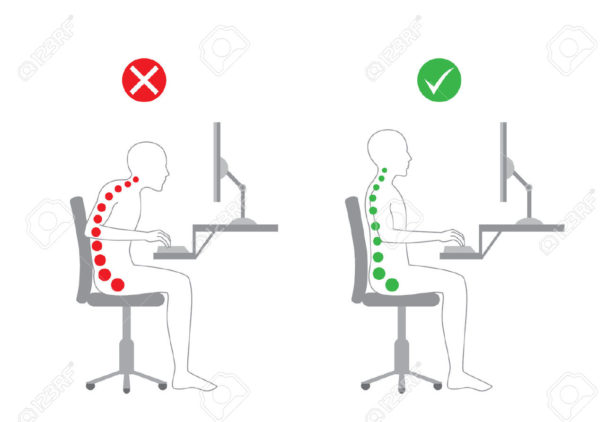
We’ve been taught how to sit properly when we were kids, then our teenage years came around together with a bit of attitude and all those valuable lessons went out the window. Fast forward a few more years and your back begins to ache… in your thirties.
It’s no secret that sitting up straight is the key to a healthy spine and joints, so in case you casually forgot the rules of sitting like a well-functioning human, here are a few tips that will help you get back into the right habit. Considering the amount of time we spend sitting down on an every day basis, you might want to keep this all very well in mind.
Disclaimer: because you might not be used to sitting up straight, it may feel a bit uncomfortable at first, but it should eventually feel like a relaxed position without any pain. However, if you do feel pain somewhere in your body when sitting properly, do not hesitate to contact your doctor as something may be wrong.
How to sit properly on a chair
Sit up straight with your shoulders, neck and head back. Your lower back should touch the back of your chair at all times.
Your feet should lay flat on the floor and your body weight should be distributed evenly between both your hips.
The angle behind your knees should be between 90 and 100 degrees. The angle between your stomach and your legs should be between 90 and 100 degrees as well.
Take a deep breath and expand your chest. This should help you find a proper straight position.
How to sit properly at a desk
Your chair height should be adjusted in relation to that of the desk. In order to do so, simply lay your hands on the desk with your elbows close to your body: the angle at your elbows should be between 90 and 120 degrees.
Your monitor should be adjusted in such a way that the top of it is at eye level. Tilt it back by a few centimeters in order to form a 10 degree angle, to help you stay straight the entire time.
Your keyboard should be close to your body and raised at a 7 degree angle. Most standard keyboards have a tray mechanism that can help you adjust the tilt accordingly. A half-raised tilt is the most ideal position. Furthermore, the keyboard should be placed in such a way on the desk to allow space for your arms and forearms.
Try to take a break every 30 minutes and go for a walk to relax the muscles and give your spine a break.
How to sit properly in a car
Begin with the seat in a very erroneous position and slowly adjust it till you get it into the best position for your body. Push it all the way back, place it low on the floor and recline it back by approximately 40 degrees.
Sit on the seat and bring it high enough for you to comfortably see the read and the dashboard. Your hips should be at the same height as your knees.
Bring the seat forward in such a way that you can press the foot pedals without having to move your back away from the seat. When you find the right distance, recline it at an approximate angle of 100 degrees. Your headrest should touch the middle of your head.
Adjust the seat cushion in order for it to support your entire thigh without cutting any circulation or touching the back of your knees.
Bring the steering wheel closer to you and downwards to prevent you from moving your arms too much.
Finally, adjust the mirrors and the seat belt according to your comfortable and healthy position.
How to sit properly on a toilet
When it comes to sitting on a toilet, things get a bit more… out of the ordinary. It turns out, the way we were taught to sit on it when we were kids is not the healthiest for our bodies.
In fact, sitting in a 90-degree position (as we usually do on a chair) or slouching forward, disrupts the passage on your waste from your colon through to the anal canal, leading to a need for extra pressure in order to let the waste pass. This has been shown to lead to problems such as constipation, irritable bowel syndrome, hemorrhoids, and even more serious conditions, such as colon cancer.
The best way to sit on the toilet? Squatting! The same way we do it when we’re in the wild and the way a lot of people do it in many different cultures, particularly around Asia, is the right way to do. Squatting at a 35-degree angle allows for everything to flow down with ease, relaxing all internal muscles and preventing any pain or discomfort of any kind.
Because converting your toilets at home is nothing short than impractical, your best bet is to use a little stool or box to place your feet on while you’re sitting on the toilet. Your bowels will love it!
Another related article that you might be interested in is “Correct posture: exercises and advice”.